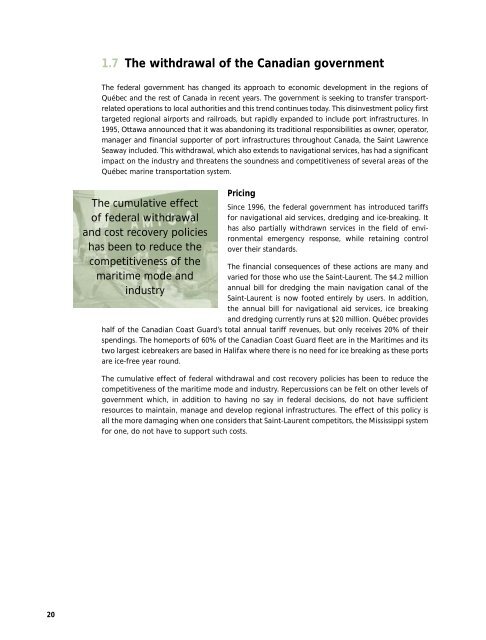Québec Marine Transportation Policy - Transport - Gouvernement ...
Québec Marine Transportation Policy - Transport - Gouvernement ...
Québec Marine Transportation Policy - Transport - Gouvernement ...
You also want an ePaper? Increase the reach of your titles
YUMPU automatically turns print PDFs into web optimized ePapers that Google loves.
20<br />
1.7 The withdrawal of the Canadian government<br />
The federal government has changed its approach to economic development in the regions of<br />
<strong>Québec</strong> and the rest of Canada in recent years. The government is seeking to transfer transportrelated<br />
operations to local authorities and this trend continues today. This disinvestment policy first<br />
targeted regional airports and railroads, but rapidly expanded to include port infrastructures. In<br />
1995, Ottawa announced that it was abandoning its traditional responsibilities as owner, operator,<br />
manager and financial supporter of port infrastructures throughout Canada, the Saint Lawrence<br />
Seaway included. This withdrawal, which also extends to navigational services, has had a significant<br />
impact on the industry and threatens the soundness and competitiveness of several areas of the<br />
<strong>Québec</strong> marine transportation system.<br />
The cumulative effect<br />
of federal withdrawal<br />
and cost recovery policies<br />
has been to reduce the<br />
competitiveness of the<br />
maritime mode and<br />
industry<br />
Pricing<br />
Since 1996, the federal government has introduced tariffs<br />
for navigational aid services, dredging and ice-breaking. It<br />
has also partially withdrawn services in the field of environmental<br />
emergency response, while retaining control<br />
over their standards.<br />
The financial consequences of these actions are many and<br />
varied for those who use the Saint-Laurent. The $4.2 million<br />
annual bill for dredging the main navigation canal of the<br />
Saint-Laurent is now footed entirely by users. In addition,<br />
the annual bill for navigational aid services, ice breaking<br />
and dredging currently runs at $20 million. <strong>Québec</strong> provides<br />
half of the Canadian Coast Guard’s total annual tariff revenues, but only receives 20% of their<br />
spendings. The homeports of 60% of the Canadian Coast Guard fleet are in the Maritimes and its<br />
two largest icebreakers are based in Halifax where there is no need for ice breaking as these ports<br />
are ice-free year round.<br />
The cumulative effect of federal withdrawal and cost recovery policies has been to reduce the<br />
competitiveness of the maritime mode and industry. Repercussions can be felt on other levels of<br />
government which, in addition to having no say in federal decisions, do not have sufficient<br />
resources to maintain, manage and develop regional infrastructures. The effect of this policy is<br />
all the more damaging when one considers that Saint-Laurent competitors, the Mississippi system<br />
for one, do not have to support such costs.


